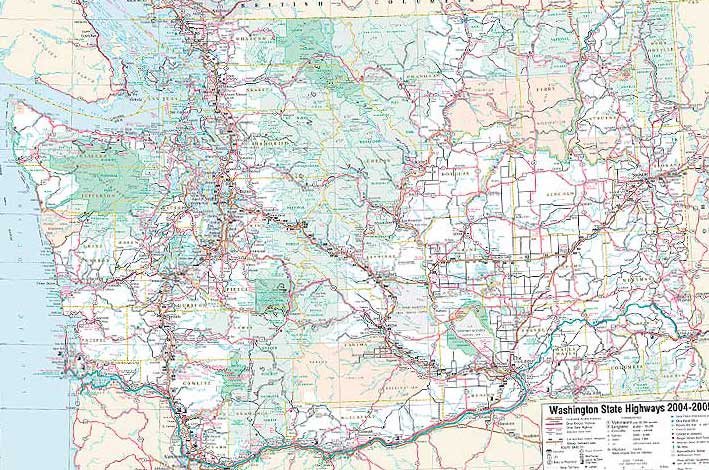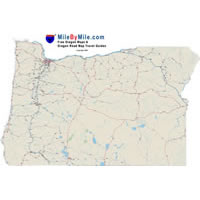Blue Highways: Umatilla, Oregon
Unfolding the Map
 For the first time since we started traveling with William Least Heat-Moon (LHM), we go back into a state that we've already visited. Okay, so a technicality might be when we passed through the Navajo and Hopi reservations from Arizona and back into Arizona, but the reservations aren't really carved out as separate states. In my mind, then, this is a first and I attach to it some symbolic qualities of a new beginning in William Least Heat-Moon's journey, especially since he had been so emotionally low in Oregon before. Where does Umatilla fit in the geography of the journey, take a look at the map!
For the first time since we started traveling with William Least Heat-Moon (LHM), we go back into a state that we've already visited. Okay, so a technicality might be when we passed through the Navajo and Hopi reservations from Arizona and back into Arizona, but the reservations aren't really carved out as separate states. In my mind, then, this is a first and I attach to it some symbolic qualities of a new beginning in William Least Heat-Moon's journey, especially since he had been so emotionally low in Oregon before. Where does Umatilla fit in the geography of the journey, take a look at the map!
Book Quote
"Across the Columbia at Umatilla, Oregon, and up the great bend of river into country where sage grew taller than men."
Blue Highways: Part 6, Chapter 10
 From McNary Dam Overlook in Umatilla, Oregon. Interstate 82 bridges over the Columbia River in foreground, and Mount Adams in the background. Photo at the Columbia River-A Photographic Journey site. Click on photo to go to host page.
From McNary Dam Overlook in Umatilla, Oregon. Interstate 82 bridges over the Columbia River in foreground, and Mount Adams in the background. Photo at the Columbia River-A Photographic Journey site. Click on photo to go to host page.
Umatilla, Oregon
Here is a first for LHM's journey in Blue Highways. In the nearly 200 places that we've visited so far, he has never doubled back into a state after leaving it. He may have meandered, and he may have wandered, but he has pretty much kept himself moving straight through states, seeing some of what they have, and then moving on without a backward glance.
So why does he dip down into Oregon again, crossing the border at Umatilla (pronounced yoo-ma-till-a - I live in a Southwest border state and my inclination is to pronounce it ooh-ma-tee-ya)) and then going up the south and east side of the Columbia River?
A simple answer is that it's where the road has taken him. If you look at the map of the area, the road he has been driving upon in Washington, state route 14, ends at Interstate 82 across the river from Umatilla. He evidently decided to cross the river on the interstate, and then pick up the Columbia River Highway (US 730) to continue his drive along a blue highway.
He also has tended, whenever possible, to avoid interstates. An alternative route might have taken him up Interstate 82 to Kennewick, where he could have then taken US 395 across the river and then started making his way east on US 12 from there. But he chose not to. Instead, he dips back into Oregon.
I don't put a lot of stock into this, but just go with me for a minute here as I look at some possible symbolism of this return to Oregon. It may be a bunch of crap, but all of my posts are my own interpretations of what I'm reading so far, so I can go out on a limb once in a while, like I have a few times in my posts.
Symbolically, it seems as if Oregon was a difficult state for LHM. Really, beginning in California, he had some despair and began questioning why he undertook this journey. He began to perceive life and our travels in it as an unending circle that just keeps bringing us back to the same point. He didn't really see the utility of that, especially since that same point always seemed to be a low point. As he moved up through Oregon, these feelings became more intense. In Corvallis, Oregon he reached his nadir. Sitting in Ghost Dancing, while it rained for days, he called his wife and she didn't want to talk to him. At that point, he decides he wants to see "what the hell is next." He continues to the coast of Oregon where Lewis and Clark reached the end point of their westward journey, and that association with the explorers seems to enliven him. After touching the coast, he turns east and at Portland, he heads into Washington. In Washington, he briefly flirts with a woman who fires his imagination. Then he meets some hang-gliding folk who discuss the thrill of the unknown and the risks involved. As we read, and travel with him, we can see his writing change as well - he gets back into the trip again and seems more excited to see what else might come his way.
Here's my stretch with the symbolism. His dip back into Oregon seems to be a return to the same state where he once languished in turmoil and low spirits. Except that now, he isn't languishing anymore. It's therefore a return to a former area of weakness but now with strength and a groundedness that lets him move through and not get stuck. It is a repudiation of negativity that put him in the blues before. And, as we'll see, he stays forward looking, moving without pause on to Wallula and to points beyond as he heads back into the state of Washington.
I do counseling because I've dealt my whole life with being stuck in places that aren't necessarily the best places for me to be. These are self-critical, self-pitying and ultimately soul-sucking places that want me to stay there. I've learned that when I leave those places they don't just disappear, just like Oregon was not going to fall off the map once LHM left it. Instead, my hard places sit there and wait for me, seemingly knowing that I'll come back by roundabout routes. If I'm not paying attention, often I end up back in them. Then I get stuck again. But lately, I've been doing something different. I've been visiting those places but in a different frame of mind and with a different reference point. Sometimes, it's hard. But other times, with a new vision and outlook, I can remake those places into something much nicer. It becomes me deciding when, how and even if I will visit, not fate or life dictating to me where I go.
Another very important and real symbol - by "real" I mean not my imagination - in the passage above is LHM's mention of sage. Sage has symbolized a number of positive concepts throughout history. On this page, I learned that sage stands for or was thought to contribute to the following:
immortality
increased mental capacity
healing
life creation
prosperity
business
curative powers
spiritual cleansing
banishing of evil spirits
In addition, sage is at the heart of a Christian legend that relates how Mary and Jesus escaped from the soldiers of Herod after Jesus' birth. They asked a rose bush to open its petals and shelter them, but the rose bush refused and told them to go to the clove plant. The clove also refused and referred them to the sage. The sage blossomed abundantly and sheltered them, and the soldiers passed them by. Since that time, the rose has been cursed with thorns, the clove with flowers that don't smell very good, and the sage has been blessed by curative powers.
Since LHM drives into an area abundant with sage, it doesn't seem to be a stretch that he is driving through a cleansing place, a healing place, and a place where the bad and even evil of the past can be banished. And maybe this is all a coincidence and means nothing. Sure, LHM could have decided to take the interstate and avoid going back into Oregon again. But he didn't, so you can draw your own conclusions.
So, that's my little foray into symbolic territory. Perhaps I've overthought this, but that's the beauty of symbolism. It doesn't have to be something that one plans out. LHM probably never even thought of this - he was just looking for a blue highway rather than the interstate. It was up to me to make whatever symbolic allusions that I perceived. But, I can take these flights of fancy because I am an unique reader and I can interpret as much as I want and I can allow my thoughts to go whither they wish. That's the beauty of reading, Littourati!
Musical Interlude
Once again, I had a song come to mind for this post. I'm not sure why it this song wanted to come forward, but it did. The title is appropriate to the post, and so enjoy Get Back by The Beatles in their famous last rooftop concert at their Apple Studio in London.
If you want to know more about Umatilla
Center for Columbia River History: Umatilla
City of Umatilla
Wikipedia: McNary Dam
Wikipedia: Umatilla
Next up: Wallula, Washington




 Wednesday, November 16, 2011 at 10:57AM
Wednesday, November 16, 2011 at 10:57AM







